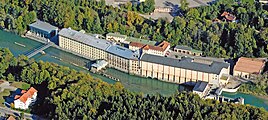Poop
|
Poop
City of Kempten (Allgäu)
Coordinates: 47 ° 42 ′ 10 ″ N , 10 ° 19 ′ 26 ″ E
|
||
|---|---|---|
| Height : | 700 m above sea level NN | |
| Residents : | 2500 (Aug 1, 1954) | |
| Incorporation : | 1972 | |
| Incorporated into: | Kempten | |
| Postal code : | 87437 | |
| Area code : | 0831 | |
|
Location of Kottern in Kempten (Allgäu) |
||
|
Former textile factory on the Iller
|
||
Kottern is a district that has risen up in the Sankt Mang district of Kempten and used to be a village. The actual meaning of the name has not been clarified. The place is closely connected to the history of the former textile factory on the Iller .
history
Paper industry
In 1449 a citizen of Kempten received interest from the estate "in der kutun". Two years later the goods "ze Kotrun" are mentioned. In 1494 the imperial city of Kempten had jurisdiction over mills and hammer mills in Kottern. In 1528 the imperial city, which had its rights confirmed in 1525, sold it to a Moriz Staiger and Peter Stähelin.
In 1585 three paper mills were operated in Kottern , and on the night of March 5, 1585, all three paper mills , although they were subjects of the imperial city of Kempten, were attacked by Vogt Dietrich von Hörben from the monastery and brought to Sulzberg Castle with their brothers . On March 12 of the same year a mandate from the Imperial Court of Justice was issued to the prince abbot for this act of violence.
At the end of the 16th century Kottern probably consisted of a hammer forge with four houses and fields as monastery fiefs. A year later, the imperial city and the Kempten monastery clarified that the imperial city could build and operate paper mills downstream from Kottern.
In 1708 all three paper mills and the two water hammers burned down. Thirty years later, none of the hammers were in use. In 1776 the Kottern water source was redesigned and the dike drive to Kempten was renewed.
In 1819, one year after the formation of the rural community of Sankt Mang , Kottern consisted of four properties with 19 people who belonged to the Hauptmannschaft Lenzfried .
Industrialization through a textile factory

In 1847 began with the acquisition of three paper mills on the Iller by Caspar Honegger , the industrialization of the Allgäu. He had a five-story textile factory and a machine factory built there by 1850. A year later, the old water wheels were dismantled, the weir systems rebuilt and the Felsenwehr hydroelectric power station built, from which a turbine supplied the power for the factory.
In 1854 the Illerbrücke was built between Kottern and Eich on the other side of the bank. Until then, a ferry service served to cross the river. Four years later a factory school was set up and a community school was built in 1880. In 1884 the length of the textile factory was completed, the machine factory on the other side of the river was demolished.
In 1900 the industrial village consisted of 52 houses with 1147 inhabitants. From 1906 to 1907 the village was canalized and in 1909 the Kottern-Neudorf station was built. In 1911 an Art Nouveau shed was built on the Illerhchterrasse.
The large Roman Catholic Church of the Assumption of the Virgin Mary was consecrated in 1922, three years later the Heroes' Cemetery on the church forecourt. The nearby Evangelical Christ Church was consecrated in 1927, the new school opened just under three years later and expanded after another five years.
World War II and post-war period
During the Second World War , 90 percent of the textile factory in Kottern was destroyed. In 1950 the reconstruction of the factory was largely completed. The community names Schelldorf , Neudorf , Kottern and Drahtzug (already belonged to Kottern) were abolished by the government of Swabia with a resolution of September 29, 1962. On the basis of the same resolution, the four parts of the settlement of Sankt Mang, whose name could no longer be abbreviated as St. Mang, were combined. Ten years later, the community in Kempten was incorporated.
In 1992 the factory was closed and all workers lost their jobs. A few years later, the factory site became a business incubator and business park.
Sports
The club TSV 1874 Kottern , founded in 1874, has several sports departments and achieved several successes at the federal level.
Individual evidence
|
Further content in the sister projects of Wikipedia:
|
||
|
|
Commons | - multimedia content |
- ^ Robert Hüttinger: Association of the central place names in the municipality of Sankt Mang Lkr. Kempten (Allgäu). In: Heimatverein Kempten (Ed.) Allgäuer Geschichtsfreund No. 68, Kempten 1968, p. 22.
literature
- Heinrich Uhlig: Sankt Mang. History of an Allgäu community. Verlag des Heimatpflegers von Schwaben, Kempten (Allgäu) 1955, pp. 395–403.

